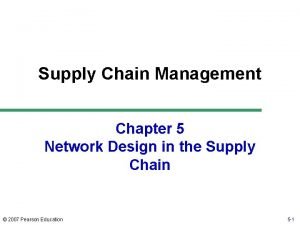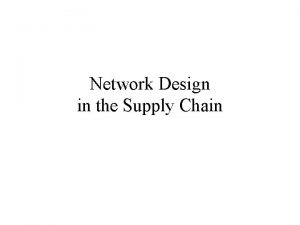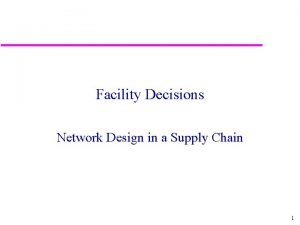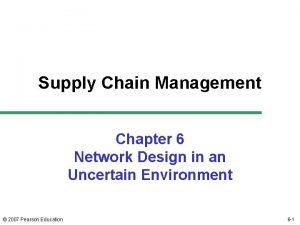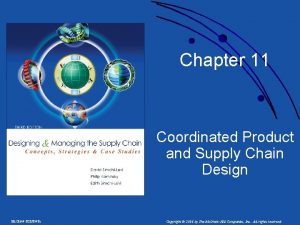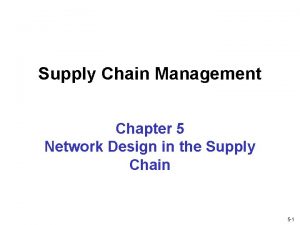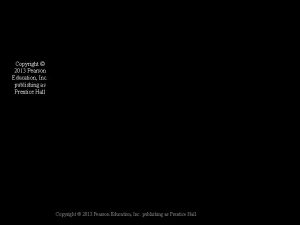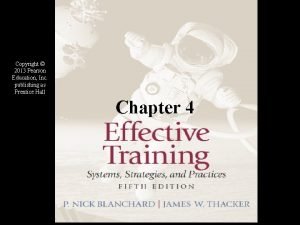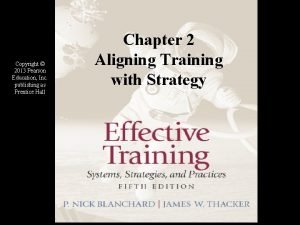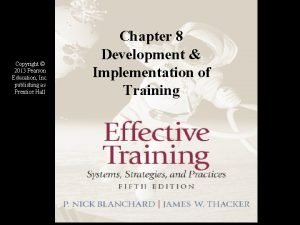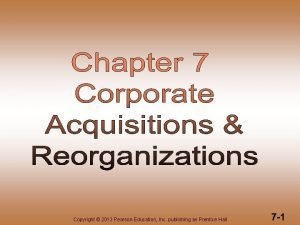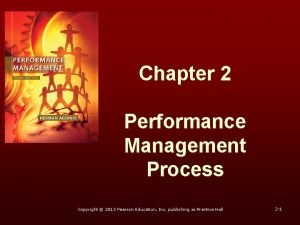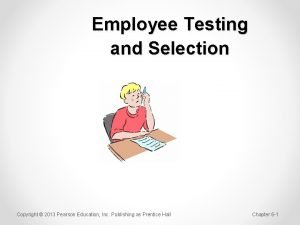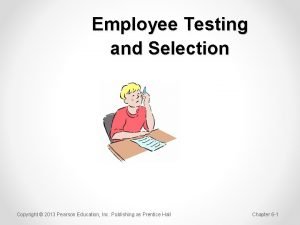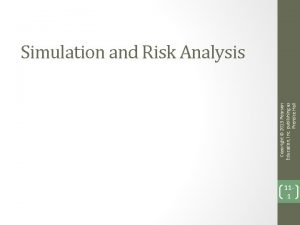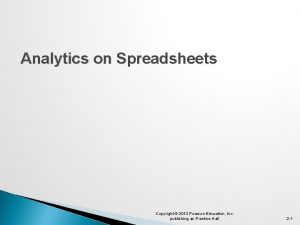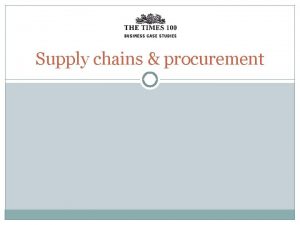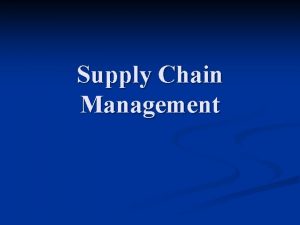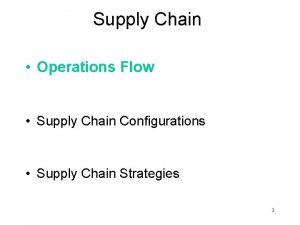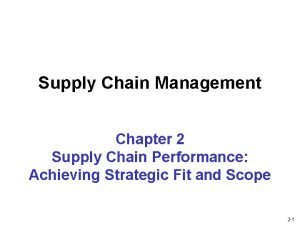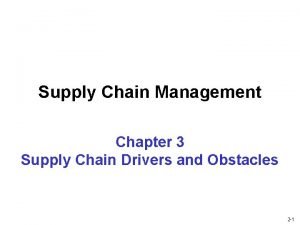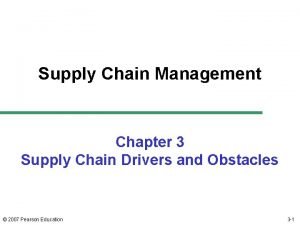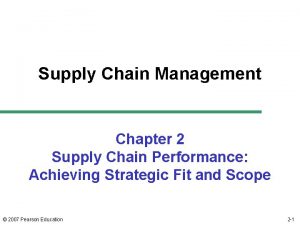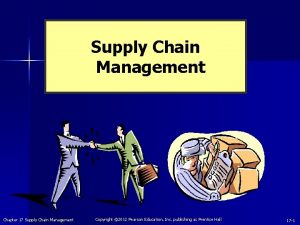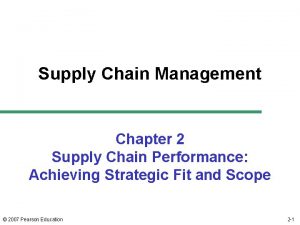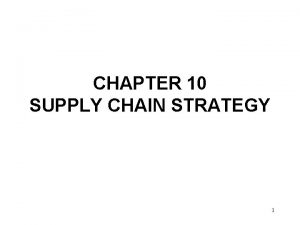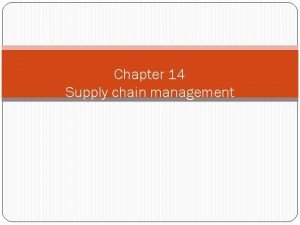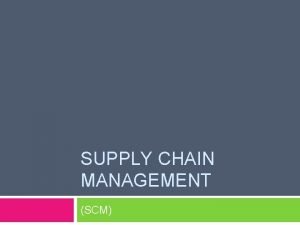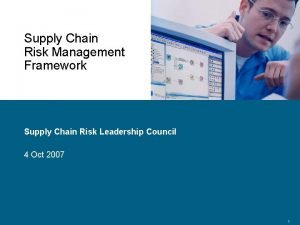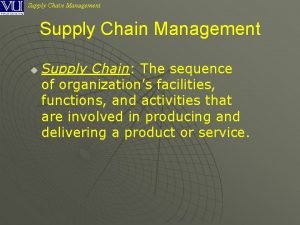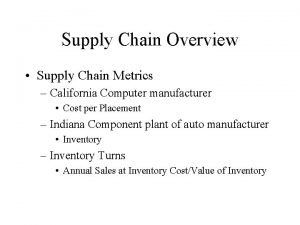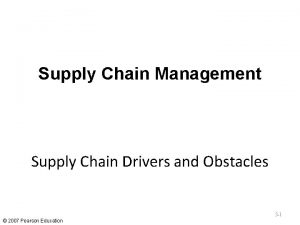Supply Chain Design Chapter 10 Copyright 2013 Pearson
































- Slides: 32

Supply Chain Design Chapter 10 Copyright © 2013 Pearson Education, Inc. publishing as Prentice Hall 10 - 0

What is Supply Chain Design? Supply Chain Designing a firm’s supply chain to meet the competitive priorities of the firm’s operations strategy. Copyright © 2013 Pearson Education, Inc. publishing as Prentice Hall 10 - 02

Creating an Effective Supply Chain Link Services/Products with External Supply Chain Link Services/Products with Internal Processes Service/Product Processes Supply Chain Link Services/Products with Customers, Suppliers, and Supply Chain Processes Copyright © 2013 Pearson Education, Inc. publishing as Prentice Hall 10 - 03

Supply Chain Efficiency Curve Total costs Inefficient supply chain operations Area of improved operations Reduce costs Improve performance New supply chain efficiency curve with changes in design and execution Supply chain performance Copyright © 2013 Pearson Education, Inc. publishing as Prentice Hall 10 - 04

Supply Chain Design Pressures • Dynamic sales volumes • Customer service levels • Service/product proliferation Copyright © 2013 Pearson Education, Inc. publishing as Prentice Hall 10 - 05

Service Supply Chain Flowers: Local/International Packaging Maintenance services Fed. Ex delivery service Arrangement materials Local delivery service Internet service Flowers-on-Demand florist Home customers Commercial customers Copyright © 2013 Pearson Education, Inc. publishing as Prentice Hall 10 - 06

Manufacturing Supply Chain Tier 3 Poland Tier 2 Germany Tier 1 USA Canada Mexico Germany Australia USA Mexico Malaysia China USA Manufacturer Ireland USA East Components Major subassemblies Assembly Ireland West Coast Raw materials East Europe West Europe Copyright © 2013 Pearson Education, Inc. publishing as Prentice Hall Distribution centers Retail 10 - 07

Inventory Measures Average aggregate inventory value Number of = units of item A typically on hand Value of each unit of item A Number of + units of item B typically on hand Value of each unit of item B Weeks of supply = Average aggregate inventory value Weekly sales (at cost) Annual sales (at cost) Inventory turnover = Average aggregate inventory value Copyright © 2013 Pearson Education, Inc. publishing as Prentice Hall 10 - 08

Example 10. 1 The Eagle Machine Company averaged $2 million in inventory last year, and the cost of goods sold was $10 million. The breakout of raw materials, work-in-process, and finished goods inventories is on the following slide. The best inventory turnover in the company’s industry is six turns per year. If the company has 52 business weeks per year, how many weeks of supply were held in inventory? What was the inventory turnover? What should the company do? Copyright © 2013 Pearson Education, Inc. publishing as Prentice Hall 10 - 09

Example 10. 1 Copyright © 2013 Pearson Education, Inc. publishing as Prentice Hall 10 - 10

Example 10. 1 The average aggregate inventory value of $2 million translates into 10. 4 weeks of supply and 5 turns per year, calculated as follows: Weeks of supply = $2 million = 10. 4 weeks ($10 million)/(52 weeks) Inventory turns = $10 million $2 million = 5 turns/year Copyright © 2013 Pearson Education, Inc. publishing as Prentice Hall 10 - 11

Application 10. 1 A recent accounting statement showed total inventories (raw materials + WIP + finished goods) to be $6, 821, 000. This year’s “cost of goods sold” is $19. 2 million. The company operates 52 weeks per year. How many weeks of supply are being held? What is the inventory turnover? Average aggregate inventory value Weeks of supply = Weekly sales (at cost) = $6, 821, 000 = 18. 5 weeks ($19, 200, 000)/(52 weeks) $19, 200, 000 = 2. 8 turns Inventory turnover = $6, 821, 000 Copyright © 2013 Pearson Education, Inc. publishing as Prentice Hall 10 - 12

Measures of Supply Chain Financial Performance • Financial measures – Total revenue – Cost of goods sold – Operating expenses – Cash flow – Working capital – Return on assets (ROA) Copyright © 2013 Pearson Education, Inc. publishing as Prentice Hall 10 - 13

SCM Decisions Affecting ROA Total revenue Increase sales through better customer service Net income Cost of goods sold Improve profits with greater revenue and lower costs Reduce costs of transportation and purchased materials Operating expenses Reduce fixed expenses by reducing overhead associated with supply chain operations Net cash flows Improve positive cash flows by reducing lead times and backlogs Inventory Increase inventory turnover Return on assets (ROA) Working capital Reduce working capital by reducing inventory investment, lead times, and backlogs Fixed assets Reduce the number of warehouses through improved supply chain design Increase ROA with higher net income and fewer total assets Total assets Achieve the same or better performance with fewer assets Copyright © 2013 Pearson Education, Inc. publishing as Prentice Hall 10 - 14

Inventory Placement • Centralized placement • Inventory pooling • Forward placement Copyright © 2013 Pearson Education, Inc. publishing as Prentice Hall 10 - 15

What is Mass Customization? Mass customization A strategy whereby a firm’s highly divergent processes generate a wide variety of customized services or products at reasonably low costs. Copyright © 2013 Pearson Education, Inc. publishing as Prentice Hall 10 - 16

Mass Customization • Competitive advantages – Managing customer relationships – Eliminating finished goods inventory – Increasing perceived value of services or products • Supply chain design for mass customization – Assemble-to-order strategy – Modular design – Postponement Copyright © 2013 Pearson Education, Inc. publishing as Prentice Hall 10 - 17

Supply Chain Design for Assemble-to-Order Strategy Order based on forecast Customer order Supply as Standardized needed Component supplier component inventory Supply to forecasted demand Fabrication Assembly Customer Supply as needed Copyright © 2013 Pearson Education, Inc. publishing as Prentice Hall 10 - 18

Outsourcing Processes • Make-or-buy decision • Vertical integration – Backward integration – Forward integration • Outsourcing – Offshoring Copyright © 2013 Pearson Education, Inc. publishing as Prentice Hall 10 - 19

Outsourcing Decision Factors • • Comparative Labor Costs Rework and Product Returns Logistics Costs Tariffs and Taxes Market Effects Labor Laws and Unions Internet Copyright © 2013 Pearson Education, Inc. publishing as Prentice Hall 10 - 20

Outsourcing Potential Pitfalls • Pulling the Plug too Quickly • Technology Transfer • Process Integration Copyright © 2013 Pearson Education, Inc. publishing as Prentice Hall 10 - 21

Example 10. 2 Thompson manufacturing produces industrial scales for the electronics industry. Management is considering outsourcing the shipping operation to a logistics provider experienced in the electronics industry. Thompson’s annual fixed costs of the shipping operation are $1, 500, 000, which includes costs of the equipment and infrastructure for the operation. The estimated variable cost of shipping the scales with the inhouse operation is $4. 50 per ton-mile. If Thompson outsourced the operation to Carter Trucking, the annual fixed costs of the infrastructure and management time needed to manage the contract would be $250, 000. Carter would charge $8. 50 per ton-mile. What is the break-even quantity? Copyright © 2013 Pearson Education, Inc. publishing as Prentice Hall 10 - 22

Example 10. 2 Fm – Fb Q= c –c b m 1, 500, 000 – 250, 000 = 8. 50 – 4. 50 = 312, 500 ton-miles Copyright © 2013 Pearson Education, Inc. publishing as Prentice Hall 10 - 23

Strategic Implications • Efficient supply chains – Build-to-stock • Responsive supply chains – Assemble-to-order – Make-to-order – Design-to-order Copyright © 2013 Pearson Education, Inc. publishing as Prentice Hall 10 - 24

Environments Factor Efficient Supply Chains Responsive Supply Chains Demand Predictable, low forecast errors Unpredictable, high forecast errors Competitive priorities Low cost, consistent quality, on-time delivery Newservice/product introduction Contribution margins Product variety Infrequent Development speed, fast delivery times, customization, volume flexibility, variety, top quality Frequent Low High Copyright © 2013 Pearson Education, Inc. publishing as Prentice Hall 10 - 25

Design Features Factor Efficient Supply Chains Operation strategy Capacity cushion Inventory investment Lead time Supplier selection Responsive Supply Chains Make-to-stock or Assemble-to-order, makestandardized services or to-order, or customized products; emphasize high service or products; volumes emphasize variety Low High Low; enable high inventory As needed to enable fast turns delivery time Shorten, but do not Shorten aggressively increase costs Emphasize low prices, Emphasize fast delivery consistent quality, on-time, customization, delivery variety, volume flexibility, top quality Copyright © 2013 Pearson Education, Inc. publishing as Prentice Hall 10 - 26

Supply Chain Design Link to Processes Process Customized Small Batch Large Batch Incr Resp onsi easi n ve S uppl y Ch ain Standardized Service/Product Characteristics Job Incr Line Continuous Flow g su pply cha in fl exib ility easi Effic ng ient serv ice/ pro duc t vo Supp ly Ch ain lum e Copyright © 2013 Pearson Education, Inc. publishing as Prentice Hall 10 - 27

Solved Problem A firm’s cost of goods sold last year was $3, 410, 000, and the firm operates 52 weeks per year. It carries seven items in inventory: three raw materials, two work-in-process items, and two finished goods. The following table contains last year’s average inventory level for each item, along with its value. a. What is the average aggregate inventory value? b. How many weeks of supply does the firm maintain? c. What was the inventory turnover last year? Category Raw materials Work-inprocess Finished goods Part Number Average Level Unit Value 1 15, 000 $ 3. 00 2 2, 500 5. 00 3 3, 000 1. 00 4 5, 000 14. 00 5 4, 000 18. 00 6 2, 000 48. 00 7 1, 000 62. 00 Copyright © 2013 Pearson Education, Inc. publishing as Prentice Hall 10 - 28

Solved Problem a. Part Number Average Level 1 15, 000 $ 3. 00 = 2 2, 500 5. 00 = 3 3, 000 1. 00 = 4 5, 000 14. 00 = 5 4, 000 18. 00 = 6 2, 000 48. 00 = 7 1, 000 62. 00 = Unit Value Total Value Average aggregate inventory value = Copyright © 2013 Pearson Education, Inc. publishing as Prentice Hall 10 - 29

Solved Problem a. Part Number Average Level 1 15, 000 $ 3. 00 = $ 45, 000 2 2, 500 5. 00 = 12, 500 3 3, 000 1. 00 = 3, 000 4 5, 000 14. 00 = 70, 000 5 4, 000 18. 00 = 72, 000 6 2, 000 48. 00 = 96, 000 7 1, 000 62. 00 = 62, 000 Average aggregate inventory value = $360, 500 Unit Value Copyright © 2013 Pearson Education, Inc. publishing as Prentice Hall Total Value 10 - 30

Solved Problem b. Average weekly sales at cost = $3, 410, 000/52 weeks = $65, 577/week Average aggregate inventory value Weekly sales (at cost) Weeks of supply = = c. Inventory turnover = $360, 500 $65, 577 = 5. 5 weeks Annual sales (at cost) Average aggregate inventory value $3, 410, 000 = = 9. 5 turns $360, 500 Copyright © 2013 Pearson Education, Inc. publishing as Prentice Hall 10 - 31

All rights reserved. No part of this publication may be reproduced, stored in a retrieval system, or transmitted, in any form or by any means, electronic, mechanical, photocopying, recording, or otherwise, without the prior written permission of the publisher. Printed in the United States of America. Copyright © 2013 Pearson Education, Inc. publishing as Prentice Hall 10 - 32
 Tailored network in supply chain
Tailored network in supply chain Matching supply and demand in supply chain
Matching supply and demand in supply chain Difference between logistics and supply chain
Difference between logistics and supply chain Eltonian pyramid
Eltonian pyramid Mbti personal impact report
Mbti personal impact report Framework for network design decisions
Framework for network design decisions Factors that influence network design decisions
Factors that influence network design decisions Supply chain network design decisions include
Supply chain network design decisions include Coordinated product and supply chain design
Coordinated product and supply chain design Supply chain management network design
Supply chain management network design 2013 pearson education inc
2013 pearson education inc 2013 pearson education inc
2013 pearson education inc Performance gap
Performance gap 2013 pearson education inc
2013 pearson education inc 2013 pearson education inc
2013 pearson education inc 2013 pearson education inc
2013 pearson education inc 2013 pearson education inc
2013 pearson education inc 2013 pearson education inc
2013 pearson education inc 2013 pearson education inc
2013 pearson education inc 2013 pearson education inc
2013 pearson education inc 2013 pearson education inc. answers
2013 pearson education inc. answers Employee testing and selection
Employee testing and selection 2013 pearson education inc
2013 pearson education inc 2013 pearson education inc
2013 pearson education inc Pearson education ltd
Pearson education ltd Copyright by pearson education inc. answers
Copyright by pearson education inc. answers Copyright 2010 pearson education inc
Copyright 2010 pearson education inc 2009 pearson education inc
2009 pearson education inc Copyright pearson education inc
Copyright pearson education inc Copyright 2014 pearson education inc
Copyright 2014 pearson education inc Copyright 2010 pearson education inc
Copyright 2010 pearson education inc Copyright 2010 pearson education inc
Copyright 2010 pearson education inc Copyright by pearson education inc. answers
Copyright by pearson education inc. answers
